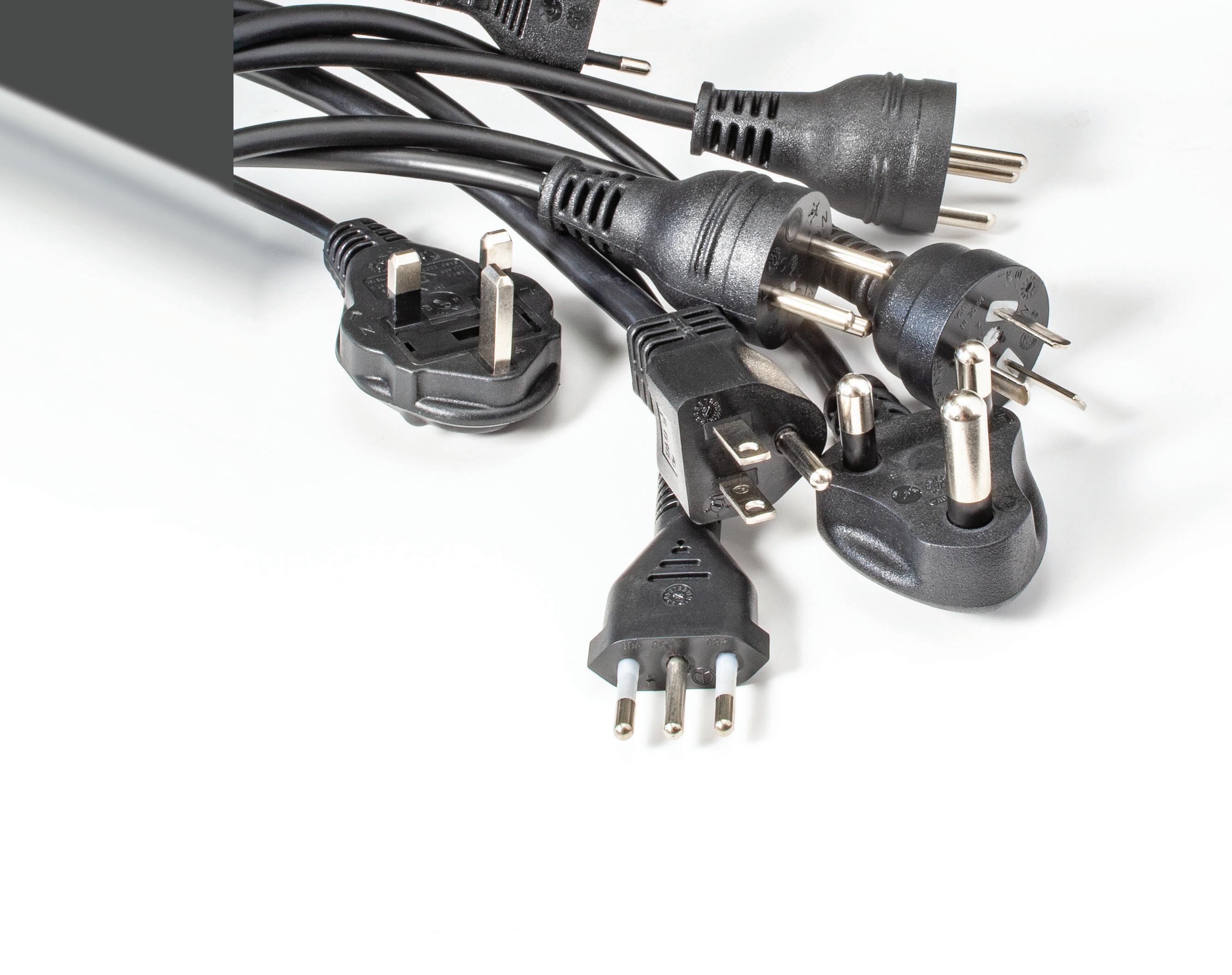
33 minute read
THINK GREEN
How consumer electronics is becoming more sustainable
BY SGS
Suppliers of consumer electronics are increasingly making their products and operations more sustainable in accordance with consumer demand. Here SGS looks at the drivers and solutions impacting this dynamic market.
Sustainability is now on the agenda for individuals, governments and industries. It has joined traditional market drivers – safety, performance and price – in being a consideration when consumers want to buy a new product.
The Consumer Electronics Association acknowledged the importance of taking a more proactive approach to positive environmental, social and corporate governance - stating “Future success will be determined as much by our stewardship to the environment, as to consumers, employees & business partners.”
Environmental Impact
We have grown to rely on a wide variety of consumer electronic devices, but this dependence comes at a price. We are estimated to currently using 1.75 planets worth of resources, a figure that is to rise to two planets by 2030. This is more than the planet can replenish and added to this, deforestation and some mining operations are intensifying the problem. Alongside resource use, there are problems associated with increased energy use, higher greenhouse gas (GHG) emissions, and a lack of effective recycling.
The UN estimates humans generate 50 million tonnes of electrical and electronic (EE) waste every year and the problem is expected to increase to 120 million tonnes by 2050. However, currently only 20% of this is formally recycled. This is a wasted opportunity. Annual e-waste is valued at USD 62.5 billion, more than the GDP of some countries. It is estimated that approximately up to 7% of the planet’s gold is lost in e-waste.
There are also environmental concerns over energy use. In the US, residential energy use has steadily been increasing in previous decades and now stands at 22% of total energy use. This is despite improvements brought about by greater insulation and more efficient appliances.
Two factors are impacting these figures. Firstly, the number of households in the US has grown enormously in the last four decades – from 80 million in 1980 to 128 million in 2020. Secondly, we now have multiple devices in every room and even in our pockets. These require electricity, the generation of which is increasing GHG emissions.
Here is how the consumer electronics industry is responding.
Recycling and greater use of recycled materials are just two aspects of the ultimate sustainability goal...Another important focus is the reduction in obslescence and the ability to repair.
Recycling
Recycling reduces the need to extract new resources. Many of the materials used in consumer electronics and their packaging can be sourced from recycled resources. For example, some computer manufacturers are using recycled materials, including plastic resins, to build their products.
Some markets are also introducing initiatives that foster greener solutions to e-waste. For example, the European Union (EU) has passed directives covering the Waste of Electrical and Electronic Equipment (WEEE), Energy-related Products (ErP) and Ecodesign.
Concerns over the use of recycled materials in products relate to contamination. In some instances, this might impact safety and performance.
Reparability
Recycling and greater use of recycled materials are just two aspects of the ultimate sustainability goal, the completely circular economy where resources are made into products, used, reused and recycled multiple times. An important aspect of this is a reduction in obsolescence and the ability to repair rather than replace a product.
In 2020, France led the way with the passing of its Anti-Waste for a Circular Economy act (AGEC). Among the provisions in this act are requirements to provide information relating to the availability of spare parts, the need to use parts from a circular economy, and give time frames for repair. Built-in obsolescence techniques, including software, are banned and vendors are required to display a reparability score for each product.
These requirements will lengthen the time a product remains usable, thereby reducing overall waste. They also align with consumer demand, as a recent survey found 77% of Europeans would prefer to repair rather than replace an EE product.
Energy Efficiency
One area where EE manufacturers are making great advances is in energy consumption. Even so, with the increased prevalence of consumer electronics in our daily lives, there needs to be even greater focus on reducing GHG emissions by reducing energy usage.
Several markets already employ energy efficiency rating systems to help consumers choose better products – for example, the US ENERGY STAR program. The effectiveness of these programs in persuading companies to create more efficient products is demonstrated by the fact the EU had to introduce a new energy labeling system in January 2019 when the previous version became obsolete.
Electronic OEMs have made great advances in reducing energy use and GHG emissions. Examples from leading electronics companies include 70% greater efficiency in products compared with 10 years ago.
Packaging
Being greener also means using less packaging. Many businesses are now addressing this problem by using more sustainable materials, replacing virgin materials with recycled, bio-based or compostable materials.
Four ways the wireless power industry will evolve
New methods coming to designers in 2022
BY JACOB BABCOCK, CEO & FOUNDER, NUCURRENT
New methods of contactless power transfer and battery charging are transforming how we experience technology at home, in the office and on the go. Whether it’s delivering power to an EV without having to plug it in, or charging your fitness band without ever having to take it off, these wireless power technologies are making significant inroads into our day-to-day lives.
This past year witnessed substantial progress, though: notably, the NFC Forum, the global standards and advocacy association for Near Field Communication (NFC) technology, announced the Wireless Charging Specification (WLC) 2.0 in October. The WLC 2.0 enables easier and more convenient charging of low-power devices, like wireless earbuds, smart watches, digital stylus pens, headsets and fitness trackers. WLC 2.0 also supports even smaller antenna sizes, expanding the range of small, battery-powered consumer and IoT devices that can be wirelessly charged using smartphone and other NFC-enabled devices. This announcement was transformative, enabling device manufacturers and solution providers to design smaller, lighter and more affordable wireless products able to communicate with, and charge alongside smartphones and other NFC-enabled devices.
Advances in NFC technology are also starting to make an impact on design and manufacturing. Since NFC charging addresses so many pain points of current wireless charging methods, physical charging contacts and connectors can be removed, improving device durability and waterproofing - especially important for health and fitness wearables. Additionally, by being able to transfer power and data over the air, designers can develop wireless uART solutions, eliminating the need for data ports and allowing for wireless debugging, testing and software updates. 2021 showed the breadth of wireless power applicability across a number of industries, but only went an inch deep on its potential. The next year will allow us to go deeper, with a number of exciting changes expected.
Wireless wins out
Physical connectors were invented over 125 years ago - before we were driving Model Ts and the radio wasn’t yet invented. While the past five years have laid significant evidence that a shift is occurring (iPhones, earbuds, EVs, wearables, etc.), 2022 is when mainstream devices start catching up with the early adopters of game-changing wireless technology.
Connectors, while originally practical, now serve mainly as a vulnerability for devices. While they allow engineers access to the inner workings of a device, physical connectors also make devices less durable, less waterproof and more expensive to build and maintain. Embracing wireless connectors bring both design and user benefits, by making devices sleeker, more durable, and waterproof; and also less cluttered with cables. Wearables like fitness bands, medical devices and earbuds will be among the first adopters, as their small size and low power needs are extremely well-suited to the benefits of wireless charging.
Phone will become the charger as well
Advances in NFC wireless charging technology - and specifically, the WLC 2.0 - will establish a new category of wireless charging over the next year, as smartphones will become charging transmitters for small, space-constrained devices like earbuds, fitness bands and styluses.
Major tech companies are taking note, as many of the leading
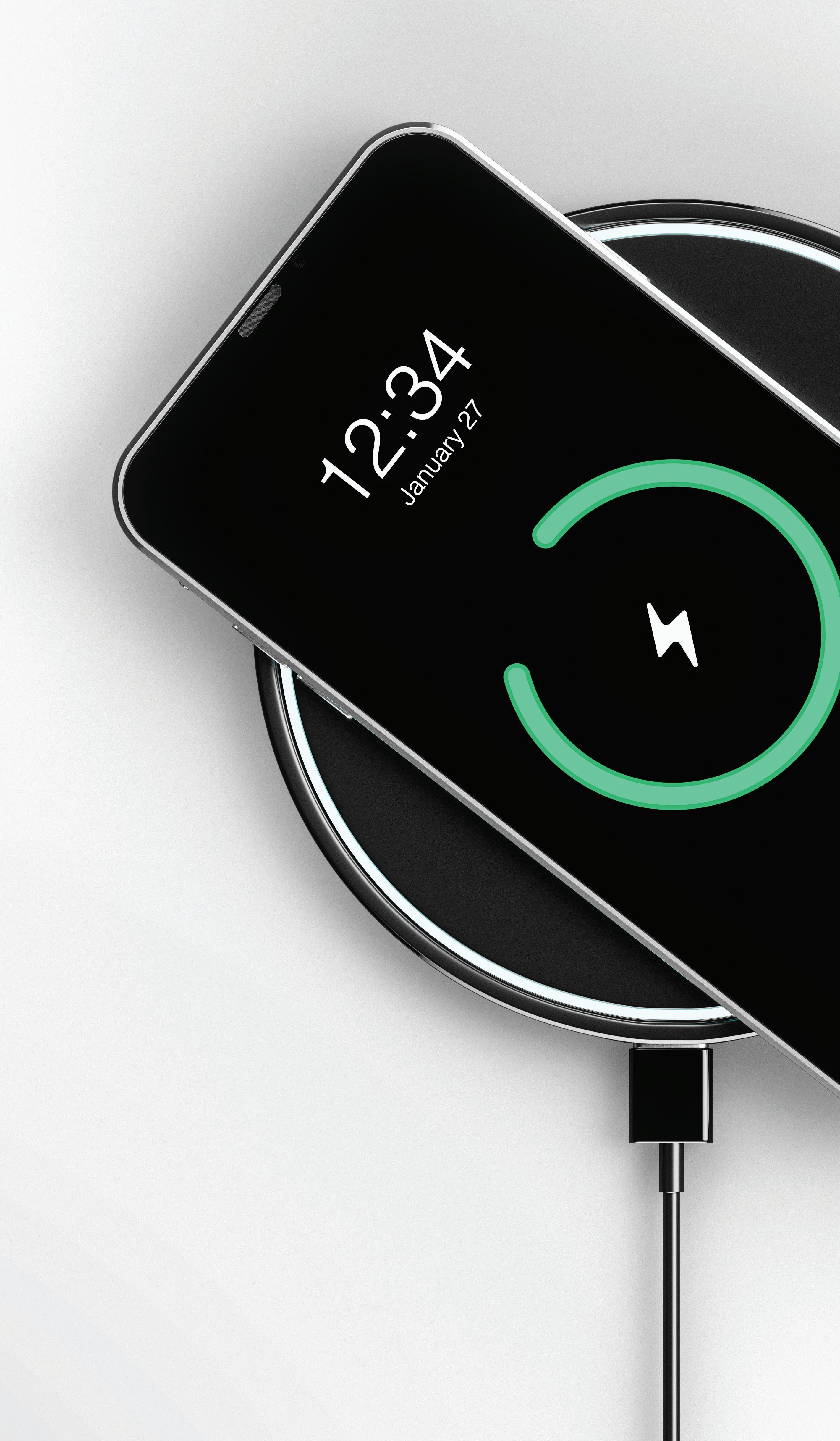
As OEMs advance ESG initiatives designed to eliminate waste and streamline efficiency, passive sensing platforms represent a potentially attractive solution.
2.0
WLC
Enables easier and more convenient charging of low-power devices, like earbuds, smart watches, fitness trackers and digital stylus pens. smartphone manufacturers also produce earbuds, eyeglasses and wearables. This emerging NFC ecosystem will be mutually beneficial, using NFC as a platform for data and power transfer between devices and strengthening the user experience.
The concept of a connector-less smartphone - and especially one that’s also charging your wearables - may seem like fantasy to those of us with plugged-in smartphones sitting on our desks, but that future is one that’s much closer than we may think. Apple recently filed a patent to incorporate wireless charging capabilities into Macbooks and iPads, enabling these products to reverse-charge mobile devices, like phones, watches and earbuds.
NFC charging is paving the way for a new standard and user experience across devices, leveraging the power of wireless charging to offer longer-lasting, streamlined charging abilities.
Being passive progressive
Smartphones and other personal electronics like fitness trackers, smartwatches and hearables, have an increasingly growing number of sensors inside them. These do everything from detecting motion to measuring vital signs and more. Typically sensors in these devices are active components, making them more resource intensive than passive sensing activity.
As electronics manufacturers advance ESG initiatives designed to eliminate waste and streamline efficiency, passive sensing platforms represent a potentially attractive solution. The opportunity becomes even more compelling as we see more and more parts shortages due to global supply chain challenges, since these passive components also represent an alternative design path for product developers. Ultimately these passive sensor platforms will be a positive step towards addressing important consumer, business and environmental concerns. Supply chain woes stifle innovation
Speaking of the supply chain, unfortunately, our problems are far from over. Not only will current logistical issues persist, but the macro influence of the supply chain crisis is poised to have an even greater impact.
Beyond product shortages, supply chain problems will inevitably disrupt innovation on a wide scale. Imagine you’re a product developer at a major hardware company. As you grapple with how to pivot as deliveries of chips and other product components slow down - or even stop - you’re forced to put future-looking plans on hold, as you scramble to ensure current products can make it on shelves. Attempting to solve for this shortage and keep existing lines running severely limits the available time and resources to be spent on the research and development of new and innovative products.
Big companies with significant budgets will smartly tap specialists outside of their organizations to retain innovation, while smaller organizations will be stuck between a rock and a hard place.
As wireless power technology continues to advance, we will see a range of new applications as product developers see the benefits of transferring power (and data) without physical connectors. Of course, there will continue to be challenges, too. But as we head into 2022, we are expecting giant leaps forward in our industry.
Jacob Babcock, CEO & founder, NuCurrent, which was founded out of a graduate-student project at Northwestern University that focused on powering implanted neurostimulation devices wirelessly. From 2009-2013, NuCurrent concentrated exclusively on wireless power for implanted medical devices. The group’s original motivation was to develop a new type of antenna technology to deal with complex issues like transmitting power through inconsistent human tissue, Specific Absorption Rate (SAR) limits, tissue heating, implant variability, and significant size restrictions.
REDEL 2P series High Voltage
• 3 High Voltage configuration (2, 5 & 8 contacts) • Test Voltage higher than 10 kV AC • Compliant IEC 60601-1 (3rd Ed.) - Electrostatic discharge 15 kV - User safety (2MOOP/2MOPP) - Touch proof • PSU and PEI shells • Sterilizable by gas or by steam • Water-resistant models up to IP66 • Lightweight and compact design • Several keyings / colour codings • Blind mating 3 guides, 100% scoop proof • UL94 V-0 certified
LEMO Canada Inc.
Phone : 905-889-5678 info-canada@lemo.com www.lemo.com/contact facebook.com/lemoconnectors linkedin.com/company/lemo-sa
Making accurate 5G mmWave measurements with a signal analyzer
BY DYLAN MCGRATH, KEYSIGHT TECHNOLOGIES
The commercialization phase of 5G is in full swing. Currently, 5G has been deployed in more than 26,000 sites and counting. However, the vast majority of 5G deployments to date have been Frequency Range 1, sub-6GHz deployments. Deployment of 5G Frequency Range 2 (FR2) has only just begun.
Most, but not all FR2 resides in the millimeter wave (mmWave) spectrum. FR2 is defined as 24.25GHz to 52.6GHz. mmWave spectrum is generally considered to be the band of spectrum that resides between 30GHz and 300GHz.
The advantages of using mmWave spectrum in wireless communications have been well documented. The high frequency of mmWave frequencies makes them a very efficient way of sending large amounts of data. The amount of bandwidth available in the mmWave frequency range enables tremendous uplink and downlink speeds and the relatively small size of mmWave transmissions make mmWave suitable for operating in dense urban environments where a lot of devices are present.
In short, FR2 is where the bulk of 5G’s promised benefits reside in terms of speed, bandwidth, and latency for both standard wireless communications as we know it today and for enabling entirely new use cases.
However, as is so often the case in wireless technology, the promise of mmWave comes with strings attached. In the case of mmWave, the tradeoffs include path loss (due to the poor propagation of mmWave signals), increased signal noise (due to the inherent high noise level of wideband signals), and poor frequency responses (due to the small margin for error on
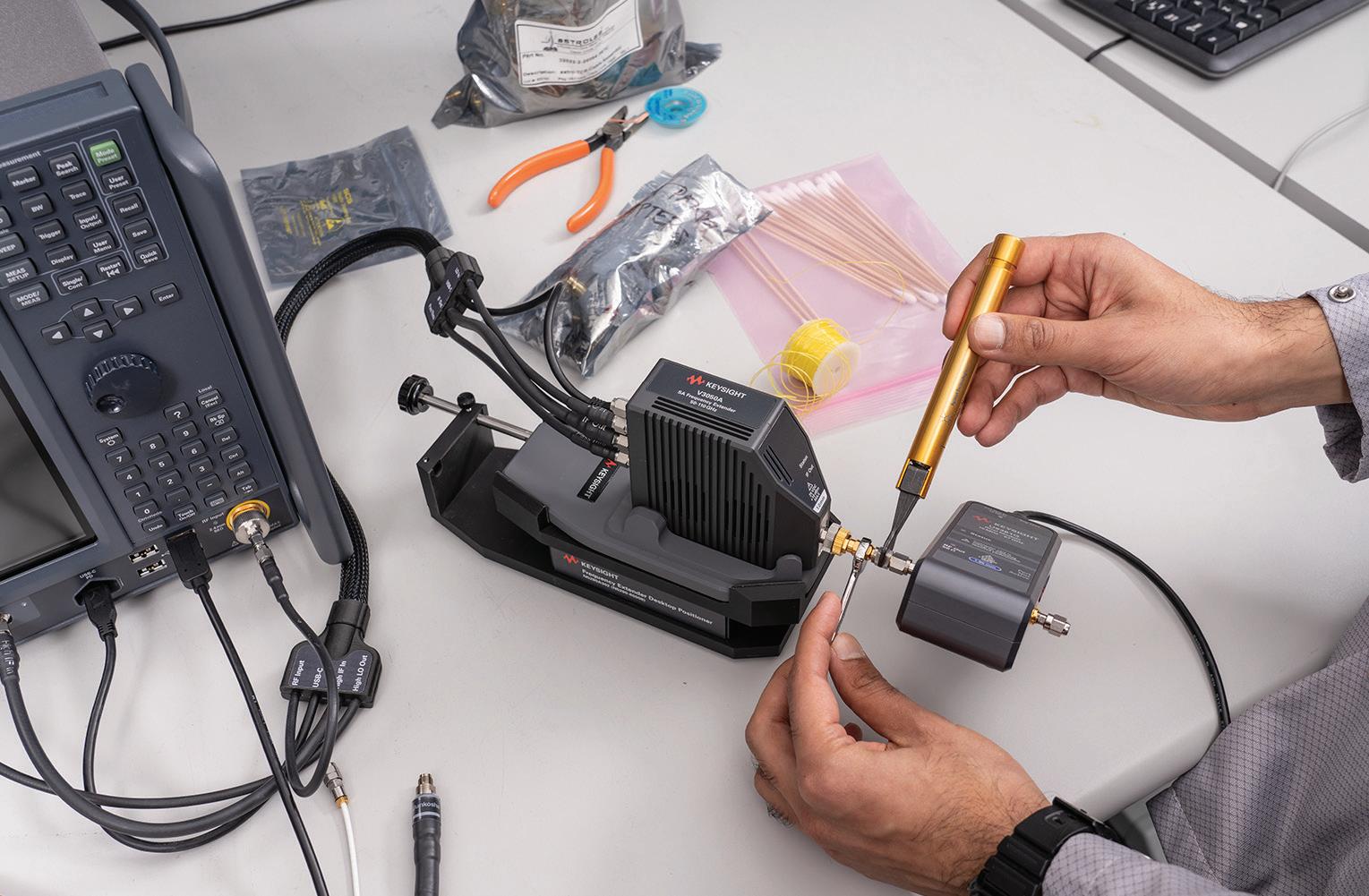
Signals may be hampered by RF cables and accessories.
wideband signals). Further complicating matters, components designed for mmWave devices are so compact and tightly integrated that it leaves no place to probe, which creates the requirement for radiated tests, also known as over the air-the-air (OTA) tests. These challenges can make measuring mmWave signals arduous, preventing you from understanding the true performance of the device under test.
This article will discuss these specific challenges to mmWave device testing in further detail. It will also present strategies for overcoming these challenges with a signal analyzer using modifications to signal path, signal conditions, and the reference plane, enabling accurate, repeatable measurement of 5G mmWave signals. Challenges to overcome
One of the most significant challenges to overcome for FR2 transmission is that mmWave signals do not propagate as far as microwave frequencies. mmWave signals are easily absorbed by the atmosphere and are more heavily impacted by rain attenuation and diffraction. mmWave signals also do not penetrate trees and other foliage, building walls, freeway overpasses, and other infrastructure.
The finnicky propagation characteristics of mmWave signals can be further exacerbated by the test setup. For example, signals may be hampered by RF cables and accessories. Also, any skew in a flange connection (above figure) on the test and measurement equipment can cause unwanted reflections that degrade signal quality and power.
Excessive path loss
The OTA testing requirement also complicates matters, because electromagnetic field behavior and characteristics vary depending on the distance from the antenna.
Excessive path loss at millimeter-wave frequencies between instruments and the device under test (DUT) results in a lower signal-to-noise ratio (SNR) for signal analysis. A lower SNR leads to less accurate transmitter measurements for things like error vector magnitude (EVM), adjacent channel power ratio (ACPR), and spurious emissions. To compensate for path loss, engineers typically reduce the attenuation of the signal analyzer. However, even reducing the input attenuation of the signal analyzer to 0 dB may not be able to compensate for the low SNR adequately to result in accurate measurements.
Signal analyzers offer engineers the hardware and software flexibility to optimize for specific types of measurements. An example is that signal analyzers offer a choice of multiple RF signal paths to help overcome path loss issues related to signal propagation and other factors. A signal analyzer can, for example, apply attenuation at higher power levels or a preamplifier at lower power levels to measure a variety of input signals.
The types of RF signal paths typically available include: • The default signal path is ideal for measurement low-level signals with a bandwidth of less than 45MHz. In this path, the input signal travels through the
RF attenuator, preamplifier, and pre-selector before reaching the mixer. • A microwave preselector bypass path is better suited for analyzing wideband vector signals such as mmWave signals because it allows wide-bandwidth signals to pass unimpeded through the RF chain. • Making EVM measurements and other measurements that test transmitter modulation quality at higher power levels is generally best done using a low-noise signal path. The gain of the amplifier, frequency responses, and insertion loss are compounded at higher frequencies. This path reduces path loss and the frequency responses and noise created by the preamplifiers and switches, improving signal fidelity and increasing measurement sensitivity. • A full-bypass signal path — which avoids multiple switches in the low-band switch circuitry and bypasses the microwave preselector — can reduce loss at mmWave frequencies by up to 10dB compared with the default signal path. The full bypass path offers the advantages of lower path loss, higher signal fidelity, and increased measurement sensitivity, but does have some downsides including in-band imaging and low SNR for testing lower power levels.
Use of an external mixer can extend the frequency range of a signal analyzer and eliminate insertion loss caused by the test setup cables and accessories between the signal analyzer and the DUT. The cable loss can be up to 5 dB/m and can reduce the SNR of the test system. Adding an external mixer, which can be moved closer to the DUT, shortens the mmWave signal path, reducing the path loss and increasing the SNR.
Wideband noise
Wideband signals inherently have higher noise and a lower SNR because energy from the signal spreads across the entire bandwidth of the signal. Hence, the wider the bandwidth, the lower the inherent signal integrity, the more vulnerable it is to noise from the test setup and other factors, and thus the lower the SNR.
Noise is part of all communications channels. A transmit signal needs to compete with the channel’s noise floor to get better sensitivity at a receiver. The Shannon-Hartley theorem specifies the maximum rate at which information can be transmitted over a communication channel within a specified bandwidth with the presence of noise.
Increasing analysis bandwidth introduces more noise to a signal analyzer. The noise reduces the SNR. As mentioned above, a low SNR causes inaccurate transmitter measurements. The low SNR can result in poor EVM and ACPR measurements that do not accurately reflect the performance of the DUT.
To improve EVM measurement accuracy, it is important to choose the optimum levels for the signal analyzer’s mixer and digitizer. It is also critical to choose the optimum phase noise con-
figuration of the local oscillator (LO) to achieve the best results.
Wireless standards specify transmitter measurements at the maximum output power. However, you can attenuate the power level at the first mixer of a signal analyzer to ensure that the high-power input signal does not distort the signal analyzer.
The input signal level can be lower than the optimum mixer level in OTA tests and tests setups with a significant insertion loss, for example. Using a built-in preamplifier can be useful for low-input-level test scenarios. A built-in preamplifier provides a better noise figure, but a poorer intermodulation-distortion-to-noise-floor dynamic range.
The input mixer-level setting is a trade-off between distortion performance and noise sensitivity. A higher input mixer level yields better SNR, while a lower input mixer level offers better distortion performance. The measurement hardware, characteristics of the input signal, and specification test requirements combine to dictate the optimum mixer-level setting. As described in example 3, applying an external low-noise amplifier (LNA) at the front end can also reduce the system noise figure — with or without the internal preamplifier — can also help optimize the input level of the mixer.
Signal analyzers also choices for phase noise optimization. The optimum phase noise performance of a signal analyzer for modulation analysis is dictated by the phase noise profile of the signal analyzer, as well as the operation frequency, bandwidth, and subcarrier spacing (OFDM signal) of the input signal. A wide offset phase noise setting is generally for better 5G NR mmWave modulation analysis.
Frequency responses
The accuracy of the test setup is impacted by the components in path between the test instrument and the DUT. With wide bandwidths and mmWave signals, small margins for error force RF engineers to look for new ways to reduce frequency response errors. These frequency response errors occur at different frequencies, affecting phase and amplitude responses. A signal analyzer provides an internal calibration routine to correct its frequency responses.
Correcting for frequency response errors is required in order to extend the measurement accuracy from the signal analyzer’s input port to the DUT’s test port. It is possible to configure corrections to both amplitude and phase with a signal analyzer to remove frequency responses. Correcting for magnitude and phase errors in the test network also improves the accuracy of measurements. There are many instruments and accessories available to help correct frequency responses.
Conclusion
In summary, the use of mmWave signals in 5G enables dramatic improvements in speed and latency, offering the performance to significantly boost traditional wireless data applications and enable entirely new use cases such as ultra-low-latency communications (URLLC), cellular vehicle-to-everything (C-V2X) communications, and massive machine-type communications (mMTC).
However, the characteristics of mmWave signals introduce new measurement challenges to accurate, repeatable measurement. Modern signal analyzers provide the flexibility in hardware and software to offset these challenges, including reducing path loss, improving signal condition, and correcting for frequency response errors.
Dylan McGrath is a veteran technology journalist and presently serving the role of senior industry solutions manager at Keysight Technologies.

Dynamic Source Manufacturing Inc. Calgary, Canada: 403 516 1888 | Tempe, USA: 480 351 7005 www.dynamicsourcemfg.com @dynamicsource_ dynamicsourcemfg DynamicSourceMfg


Electronics Manufacturing Services
With manufacturing facilities in Canada and the USA, we provide high-quality services for global industries, such as automotive, communications, energy, and security & defence. With new technologies and high volume capabilities, we bring over 20 years of experience to help you with each stage of the production cycle. As your EMS solutions partner, we evolve with you to accommodate your unique and exact requirements.
Count on us to bring your ground-breaking product to market effectively and with peace of mind. Our services include quickturn-prototyping, volume manufacturing, testing, component sourcing, and box build assembly.
SDR paves the way for 5G testbeds
BY BRENDON MCHUGH, FAE & TECHNICAL WRITER, PER VICES
For the full potential of 5G, 5G+, and mmWave technologies involved in cellular networks to be achieved, immense testing of how user equipment (UE) and base stations interact in lab simulations and real-life environments is necessary– in so-called 5G testbeds. Low power consumption, massive equipment connectivity, ultra-low latency, secure communications, cloud and edge computing services, and the deployment of technologies making all this possible, are key challenges being addressed in ongoing research on 5G networks. Software-defined radio (SDR) is a complementary technology that allows for testing many of the technologies involved in 5G networks.
What research are 5G testbeds used for?
The number of UE devices will skyrocket with emerging wireless technologies connected to 5G networks that provide internet of things (IoT) services for everything imaginable. In order for this to occur, 5G will play a central role, with support for Ultra-Reliable Low Latency Communications (URLLC), massive Machine-Type Communications (mMTC), Device-to-Device (D2D), and Machine-to-Machine (M2M) communication. These mmWave networks are expected to play a central part in a variety of IoT related services such as Intelligent Transport Systems (ITS), smart city applications, smart home tech, smart automation for Industry 4.0, and the enactment of mission-critical IoT initiatives.
With an increase in technologies requiring 5G networks will come an increase in the types of base stations (i.e. network cells), access points, and other types of interconnectivity that provide coverage for UE. The latest types of 5G connectivity include device-to-device (D2D) communication that enables direct communication between devices without going through traditional base stations central to macrocells (MCs). This helps to offload traffic from MC base stations to small cell and/ or femtocell base stations, as well as to other UE, all while increasing network cell coverage via multihop mesh network transmission. 5G networks will be much more software-driven to support the huge amount of UE using multihop mesh networks. This includes software-defined networking (SDN) architectures and multi-access edge computing (MEC) in the control plane to achieve dynamic network management, for tasks such as packet forward during D2D communication, and thereby enabling enhanced Mobile Broadband (eMBB).
All of these new base stations, IoT devices, and other UE, as well as radio communications between them all, will have their own set of protocols operating at various frequencies, and thus require extensive testing. Moreover, challenges arise due to mmWave/5G (24–54 GHz) electromagnetic waves suffering from extensive propagation loss between transmitter and receiver.

5G
The growing prevelence of user equipment, IoT, M2M, D2D communication will drive greater emphasis on 5G networks.
What is a software-defined radio (SDR)?
(Rx) and transmit (Tx) functions to receive signals over a very wide tuning range, even extending into the mmWave range. SDRs contain multiple independent Tx and Rx channels, which support MIMO operations, all with dedicated DACs/ADCs. The highest-bandwidth SDRs have 3GHz of instantaneous bandwidth, which is especially important for the immense amount of data required to be sent and received quickly over 5G networks. SDRs have a very high throughput digital backhaul, using 100GBASE-R Ethernet links, that is required for processing data and serving vast amounts of UE at very low latency.
A SDRs digital back-end contains a field-programmable gate array (FPGA) with on-board DSP capabilities for modulation, demodulation, upconverting, downconverting, as well as providing additional logic blocks for custom development. Such logic gates are configurable and upgradeable, and provide capabilities for updating to the latest radio protocols, DSP algorithms, and various other computational needs.
What does SDR bring to 5G testbeds?
Important fields of 5G research benefiting from SDR include antenna design, signal processing algorithms, propagation studies, channel estimation techniques, latency studies, as well as providing a means to share radio resources among different research groups in a testbed base stations. Moreover, to actually perform measurements, SDR is compatible with various signal processing suites, such as GNU Radio, which provide a means to take spectrum measurements or implement and test modulation schemes.
SDR-based remote radio read (RRH) are found in base stations, and are essentially RF Tx and Rx radio chains which connect to a baseband unit, allowing for a physical interface connection to the core network’s using for instance, the enhanced common public radio initiative (eCPRI).
SDRs compatible with open source software suites enable researchers to deploy and experiment with end-toend 5G networks, even though they may not have access to carrier-grade hardware deployed by the major telecom operators. Such SDRs can be deployed in testbeds, for instance in testbed base stations deployed in dense urban areas, an area of research which will be discussed in the last section.
5G Antenna, Signal Propagation and Network Testing
An important requirement for networks and UE is T&M of antennas and signal propagation. Over-the-air (OTA) testing of 5G signal transmissions is of great importance due to 5G/mmWaves having unfavorable propagation characteristics. Important tasks include measuring antenna performance, testing beamforming algorithms, and ensuring devices meet standards, for starters. In the lab, anechoic chambers can be configured for multiple purposes including antenna pattern measurements (near field), and specialized propagation measurements. For instance, channel sounding measures parameters such as signal path loss, delay, absorption & reflection off surfaces, multipath fading, angle of arrival (AoA), direction of arrival (DoA) and Doppler shifting; all parameters which affect the performance of the radio communications of a 5G network. 5G channel sounding measures channel performance dynamically on channels operating in the mmWave spectrum, using bandwidths upwards of 500MHz, over MIMO transmissions which require extensive DSP for beamforming and beam steering.
Many research studies have been conducted in the area of radio channel propagation in various indoor environments such as in offices, dining rooms in homes, stairwells, to name a few, as well as in a laboratory at 28 GHz (a prominent band for 5G wireless networks). Indoor environments provide rich sources of scattering objects for radio channel propagation studies ranging from people and objects in the building to the building itself. Structural design including construction materials, building size, and the interaction with various other aspects of systems, force EM waves to propagate across multiple paths through reflection, refraction, and diffraction phenomena. Measurements of power delay profiles are particularly important for these multipath signals. Other studies include measuring the effect of outdoor to indoor propagation of 5G signals; an obviously important task for any base station antenna.
Testbed Case studies
One interesting type of 5G testbed is shared between Rutgers, Columbia and NYU. The project, termed COSMOS (Cloud-Enhanced Open Software Defined Mobile Wireless Testbed for City-Scale Deployment), is deployed in the densely populated neighborhood of West Harlem, New York City. This testbed focuses on providing ultra-high-bandwidth and low-latency wireless communications by providing edge-computing capabilities. COSMOS allows researchers to experiment with mmWave, open RAN (ORAN), and optical switching technologies in base stations which incorporate SDR. Quantitative measurements using the testbed include scale (number of nodes, geographic coverage area, user density), radio bandwidth and speed, network latencies, and cloud computing capacity, to name a few.
COSMOS is a multi-layered computing system, with an RF plane that can flexibly divide signal processing and network function virtualization (NFV) on a SDN between a local SDR, using various FPGA functionality, and a remote cloud RAN (CRAN) with massive CPU/GPU and FPGA capabilities. 28
GHz is a prominent band for 5G wireless networks. Channel sounding measures parameters such as signal path loss, delay, absorption & reflection off surfaces,multipath fading, angle of arrival all affect performance. Conclusion
As discussed here, testbeds will be central to 5G network and UE development. High performance SDRs are playing a significant role in this development, not only for their RF capabilities but also their FPGA resources. By using SDRs, researchers are capable of testing antenna, signal propagation, signal processing, various technologies allowing massive interconnectivity, and provide a means to connect between the 5G core network (mobile backhaul) and radio fronthaul. As the 5G revolution is just underway, SDRs are expected to play a large role in these networks and devices.
Brendon McHugh is a field application engineer at Per Vices Corp. The Toronto-based firm is a leading RF and digital systems innovator and integrator supplying multiple industries with software defined radios for wireless communications. www.pervices.com
New! 016008C Series
The World’s Smallest Wirewound Chip Inductor!
• Measures just 0.47 x 0.28 mm with a height of 0.35 mm • Choose from 36 precisely-spaced L values from 0.45 to 24 nH • Higher Q than all thin film types: Up to 62 at 2.4 GH • Ideal for high-frequency applications, such as cell phones, wearable devices, and LTE/5G IoT networks Free Samples @ coilcraft.com
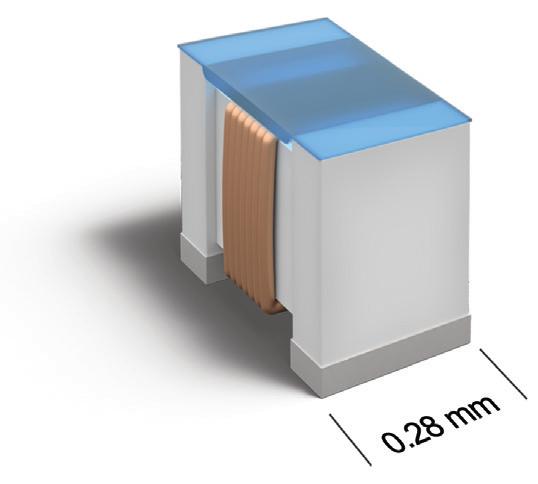
Inductor efficiency is highest when the combination of core and winding losses are the lowest.

Choosing inductors for energy efficient power
Inductors remain as integral as the circuit topology
BY LEN CRANE, SENIOR TECHNOLOGIST, COILCRAFT
In high frequency dc-dc converters, power inductors filter out the ac ripple current superimposed on the dc output. Whether the converter steps the voltage down – buck – or steps the voltage up – boost – or both up and down – SEPIC, the inductor smooths the ripple to provide a pseudo-dc output.
For battery powered applications, battery life is extended by improving the efficiency of the entire power supply circuit and inductor efficiency is often a major consideration in the design. Careful consideration of inductor efficiency can mean the difference between having your battery work when you need it and having to stop in the middle of an important task to plug it into a charger.
Inductor efficiency is highest when the combination of core and winding losses are the lowest. Therefore, the goal of highest efficiency is met by selecting an inductor that provides sufficient inductance to smooth out the ripple current while simultaneously minimizing losses. The inductor must pass the current without saturating the core or over-heating the winding.
Accurately predicting core and winding loss of an inductor can be complicated. Core loss depends on several factors, such as peak-peak ripple current, ripple current frequency, core material, core size, and turn count. The required ripple current and ripple current frequency are application-dependent, while the core material, core size, and turn count are inductor-dependent.
The most commonly-used equation to characterize core loss is the Steinmetz equation: Pcore = K(f)x(B)y Where:
Pcore = power loss in the core
K, x, y = core material constants
F = frequency
B = flux density
This equation shows that core loss depends on frequency (f) and flux density (B). Flux density depends on ripple current, so both are application-dependent variables. It also shows that the core loss is inductor-dependent, where the core material determines the K, x, and y constants. Note that flux density is also a function of the core area (Ae) and the number of turns (N), therefore core loss is both application-dependent and inductor-dependent.
By comparison, dc winding loss is simple to calculate: Pdc = Idc2 × DCR
Where:
Pdc = dc power in Watts dissipated
Idc = Effective dc (rms) value of the inductor current.
DCR = dc resistance of the inductor winding
The ac winding loss is more complicated and may include the effects of increased resistance at higher frequency due to both skin effect and proximity effect. ESR (effective series resistance) or ACR (ac resistance) curves may show some of the increased resistance at higher frequency, however, these curves are typically made at very low current levels, so they do not capture current-dependent (core) loss. They are also prone to misinterpretation.
For example, consider the ESR vs frequency curve shown in Figure 1, which indicates that the ac resistance looks very high above 1MHz. This strongly suggests that this part would have very high ac loss. However, it has been observed that inductors with typical curves like this have performed very well in actual converters – much better than would be suggested by these curves.
Consider a buck converter that has an output of 5V at 0.3A (1.5 Watts). Selecting a 10µH Coilcraft inductor with a typical ESR vs frequency operates at an ESR of 0.8 Ohms at 250kHz. The average inductor current equals the load current: 0.3A.
We can calculate the loss in the inductor as I2R = (0.3 A)2 × (0.8Ω) = 0.072 W. 0.072 W ÷ 1.5 W = about 5% of output power lost in the inductor.
If we run the same converter at 5MHz, the ESR curve shows R is between 10 Ohms and 20 Ohms. If we assume the best case R = 10 Ohms, the calculated power loss is: I2R = (0.3 A)2 × (10Ω) = 0.9W, which is 60% of the output power lost in the inductor. Switching converters achieve far better performance than the ESR curves apparently predict. How? - In typical applications, ripple current is kept to approximately 40% of the load current or less. In the 5MHz example, it was assumed the current was all ripple current (ac).
Regardless of ripple content, ESR curves are based on very low current measurements and therefore they do
Pcore
The most commonly-used equation to characterize core loss is the Steinmetz equation.
not capture current-dependent core loss at higher current. Total inductor loss determines the overall inductor efficiency. Improvements in core materials have led to inductors with very low ac loss at high frequency, resulting in higher inductor efficiency. Therefore, inductor makers optimize efficiency by selecting low loss materials and rectangular ‘flat’ wire to minimize total loss.
The XGL family stands as a good option for high frequency power converter applications that must withstand high peak current with lowest dc and ac losses.
To speed up the design process for engineers selecting inductors, Coilcraft has developed tools that calculate measurement-based core and winding loss for each possible application condition. The results from these tools include current-dependent and frequency-dependent core and winding loss, eliminating the need to request proprietary inductor design information, such as core material, Ae, and number of turns, and the need to perform hand calculations.
If your application is a dc converter, the Coilcraft dc-dc Optimizer Tool calculates the inductance value, peak current, and peakpeak current requirements, based on your operating conditions and the amount of ac ripple current you choose. It then feeds this information into our Power Inductor Finder tool to display a list of inductors that may meet these requirements. The list includes the inductance at peak current, current rating, total losses, and resulting part temperature for each inductor listed.
If you already know the inductance value and current ratings required for your application, you can enter this information directly into the Power Inductor Finder. The results include core and winding (total) loss and saturation current ratings for each inductor, to verify that the inductance will remain close to the design requirement at the peak current condition for your application.
The tool may also be used to graph the inductance vs current behavior to compare traditional hard-saturating inductors to soft saturation types. To select the highest efficiency inductor, the results can be sorted by total loss. Multiple sorts allow selection by multiple parameters.
Inductor loss is closely related to core size and wire size. In many cases, lowest loss corresponds to larger part size, or it corresponds to using a hard-saturation (ferrite) core material at lower switching frequencies. As with any design, there may be compromises that require analyzing trade-offs in size or inductance at peak current vs efficiency. Having all of the inductor information in a complete list that allows multiple sorting facilitates such an analysis.
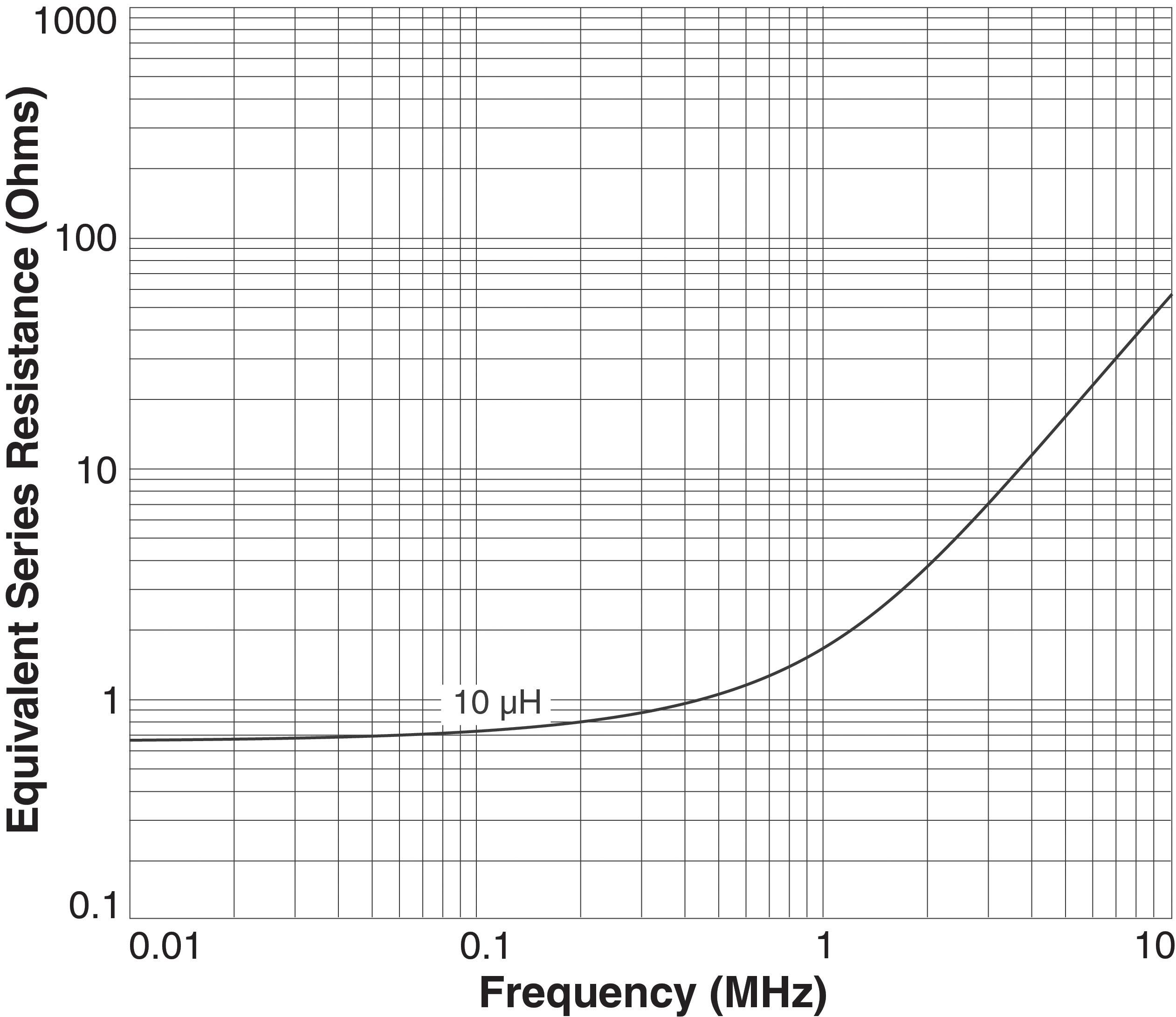
Fig 1: ESSR vs Frequency - Curve indicates that the ac resistance looks very high above 1MHz.

Table 1: Comparing XAL, XEL and XFL.
Interpower® North American and international cords and cord sets provide end users with country-specific amperages and voltages to ensure they have the correct connections to the local mains power. All Interpower cords and components are manufactured to Interpower’s product quality plan: hipot testing, continuity testing, ground testing, and multiple inspections—and ready to use straight from the box! Manufactured in Iowa, U.S.A.!
• No Minimum Order or Dollar Requirements • Quantity Price Breaks with Blanket or Scheduled Orders Value-Added Services such as Lengths, Colors, Labeling and Packaging
